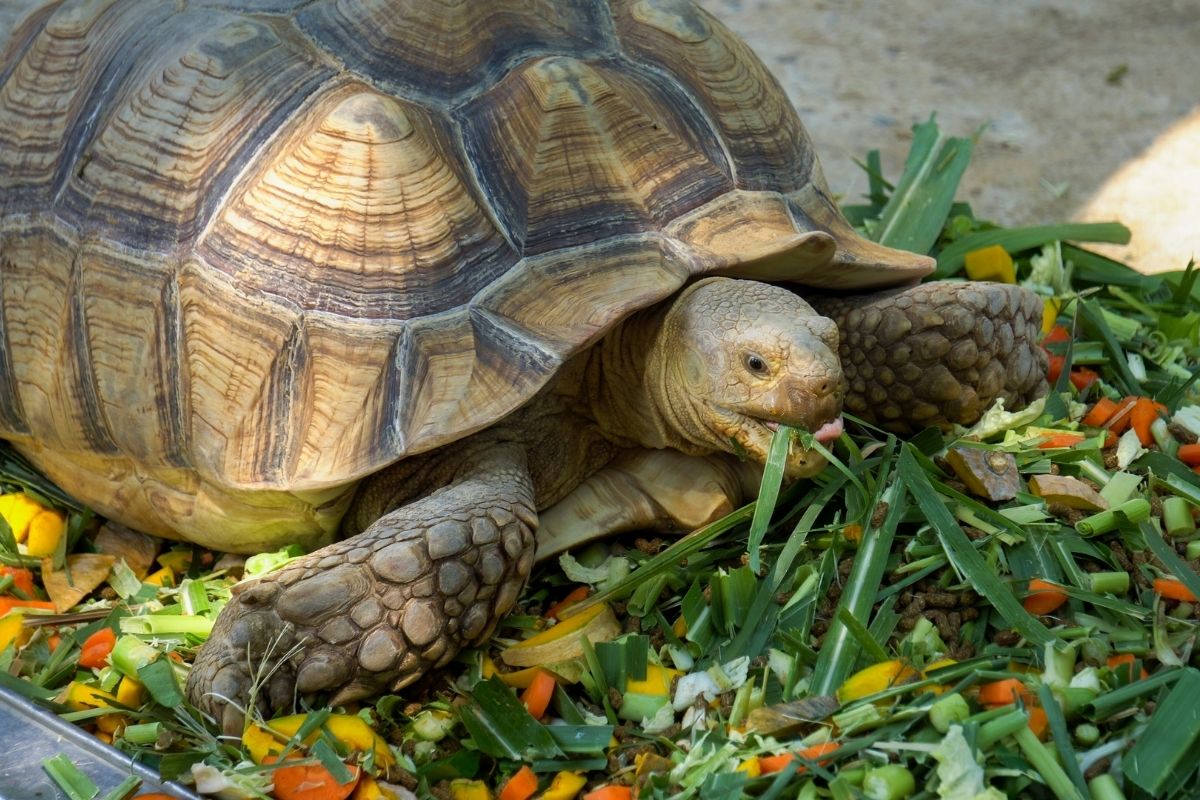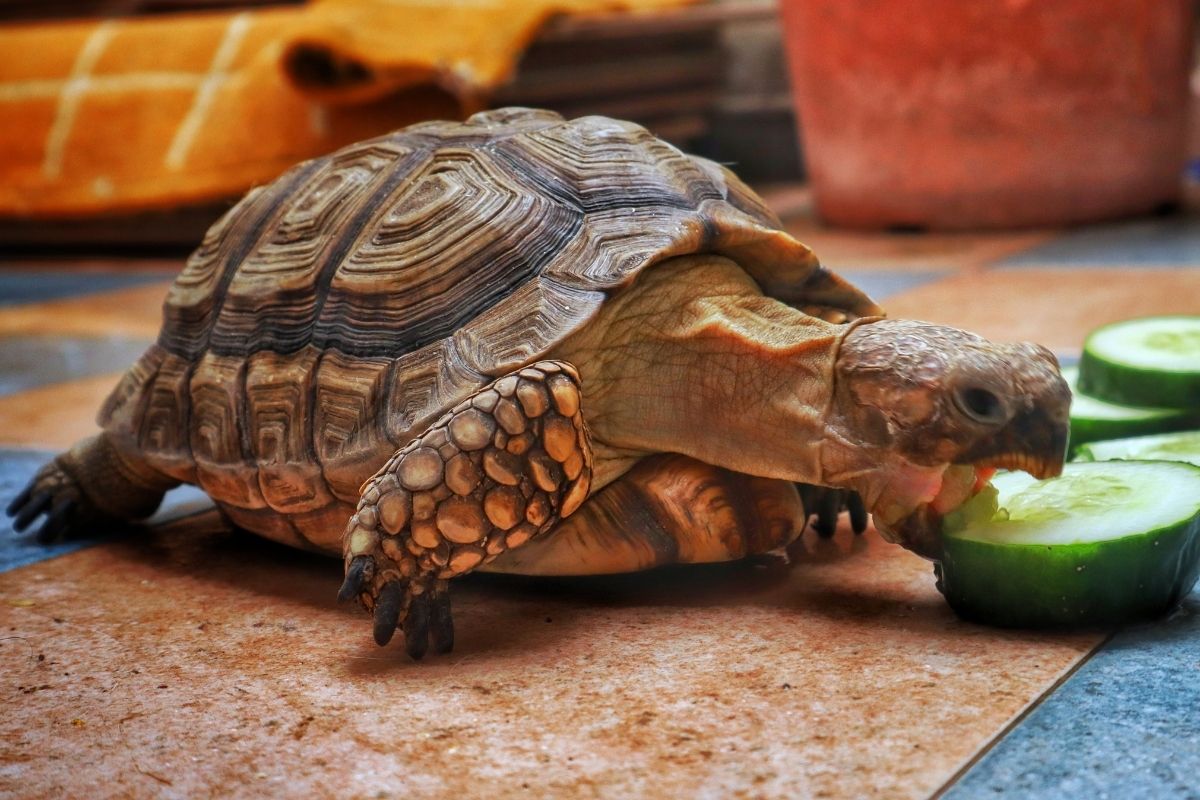Reptiles are probably one of the most fascinating animals to keep as pets.

Being so different from the usual animals we keep as companions, from dogs, cats, mice and rats, birds, and so many other mammalian or otherwise warm-blooded creatures, they are truly unique animals to play with, observe, and admire.
However, with that comes what can feel like a very different, almost alien, type of animal that has very different needs than most of your ordinary pets do.
There’s the equipment, for a start, which is very different from the normal cages and setups that you need for most pets.
Reptile pet owners have to be aware of these differences when looking after their pets.
Take our little shelled friends, for example. These groups cover a wide array of different animals that live all over the globe, with massively varying diets and lifestyles that can be hard to account for.
Perhaps most important of all, is figuring out what exactly you should be feeding them. Do you need to get them dedicated turtle or tortoise feeds?
Can their diet be supplemented with ordinary human foods? If so, which ones are safe? How much will they eat? What about supplements?
In this article, we’re going to ease some of your worries, by discussing some of the foods that this family of shelled animals can and can’t eat, such as the green stick vegetable, and celery.
We’re also going to go into a little detail about the general diet of these animals, to give you a better idea as to what sort of things you should be feeding them.
Turtles, Terrapins, And Tortoise’s Diets
To start this article off, we’re going to discuss some behaviors and diets that turtles, tortoises, and terrapins have in the wild.
Turtles
Turtles are probably the most widespread of this group of animals, thanks in part to their usual water-bound behavior and lifestyle, allowing them to move and live across large areas, and in a variety of watery habitats.
Because of this, their diets are also similarly varied.
From aquatic plants, such as lotus roots, to land-dwelling insects and small mammals, to even being scavengers of carrion, turtles are an interesting group of animals to look at and study up close.
With most species living in and around water in some regard, it makes sense that most turtle diets would be very similar to each other.
This includes foods that are naturally found in the waters where they live, including aquatic plants, algae, fungi, and whatever else might make up the aquatic environment around them.
Tortoises
Interestingly enough, whilst tortoises and turtles are part of the same family of animals, and are otherwise closely related, their different lifestyles mean that their diets are often quite different.
In the water, the slow body that turtles have on land is not an issue, as they have evolved to move around better under the waves than on the ground.
As a result, these swimming reptiles have the speed and maneuverability to actively hunt some types of fish and other sea-going life, as well as forage for plant food over large distances.
Tortoises, meanwhile, are famously slow creatures on land.
And with no way to hunt animals on land, tortoises are almost exclusively herbivorous, making them omnivorous pretty much only on a technicality!
They do, however, have a few exceptions to this rule, which means that if you want to feed them something with meat content, then the best option is to keep that to a minimum.
They will usually only eat meat if they have no other option.
Terrapins
Interestingly enough, although there are many types of reptiles that we normally call terrapins, there is little to no scientific consensus on what exactly it is.
This means that terrapins are made of several kinds of both tortoises and turtles, and as such, have very similar diets to both these different subgroups of this reptilian family.
With many species of terrapins living in and around water, we know that their dietary requirements are likely to look very similar to turtles in that respect.

Many common names used for this group of amphibious lizards come from the fact that they are generally found near or in rivers, lakes, and ponds.
As such, they need to take advantage of any nearby sources of fresh water, even if that’s rainwater coming off the roof or natural springs.
In addition, because they spend so much time out of direct sunlight, they need to be able to find plenty of shade.
And because of their wide range of available habitats, they can also use a variety of foods.
This includes invertebrates like crayfish, snails, worms, insects, crustaceans, and frogs and vegetables like lettuce, radishes, turnips, and cucumbers.
Can Turtles, Tortoises, And Terrapins Eat Celery?
So, now that we have discussed some basics of this family’s diets in the wild and captivity, we can answer the main question we posed in the introduction: Can turtles, terrapins, and tortoises eat celery?
The short answer is yes. All three of these animal groups are omnivores, meaning that their diet consists mostly of both plant and animal material.
As such, they are perfectly capable of eating most types of fruit and vegetables that humans can eat, which include celery.
However, it is worth keeping in mind that, whilst celery is fine to feed any of these three types of animals, there are very few nutritional benefits that these animals can get from these vegetables.
They will likely be able to get a decent amount of freshwater from it, thanks to the high water content of this vegetable, but not much else.
If you gave one of these three types of animals celery, they would probably go through it quickly, but that doesn’t mean they wouldn’t enjoy its flavor.
Other Fruit And Vegetables That Tortoises, Turtles, And Terrapins Can Eat
So, if tortoises, turtles, and terrapins can eat celery, what other fruit and vegetables can they eat as well?
Carrots
Carrots are another popular vegetable that people will feed to their shelled pets.
However, it should be noted that, despite being an excellent source of vitamin A, carrots are low in protein and calcium.
This means that it’s important for pet owners who are choosing to feed these veggies to make sure that their pet has access to more nutritious food.
Cucumber
Cucumber occupies a similar dietary place to celery when it comes to feeding them to your pet terrapin, turtle, or tortoise.
They are very high in water content, meaning that they are a refreshing little snack to feed your reptilian friend. But don’t expect them to benefit from it too much.

Like celery, cucumber contains no significant amounts of vitamins or minerals that can help aid health issues in your aquatic friends.
Radish
One of the more surprising fruits that these reptiles can eat is radishes. These root vegetables contain quite a lot of iron, which is essential for healthy blood cells.
Not only that, but radishes themselves are relatively easy to grow and care for, making them a good choice for those with limited space and time to devote to gardening.
Apples
Another popular food for vegetarian turtle, tortoise, and terrapin diets, apples are rich sources of potassium, Vitamin C, fiber, and many other nutrients that are beneficial to their wellbeing.
Their high water content makes them especially useful for providing hydration to your pet, so long as you choose the right apple varieties.
Lettuce
Similar to cucumbers, lettuce is another popular veggie that pet owners often find themselves giving to their pet turtles, tortoises, and terrapins.
Lettuces are relatively easy to grow, are nutrient-rich, and provide a pleasant crunchy texture that makes them ideal for adding texture and extra water-filled foods to your pet’s diets.
Bananas
Bananas provide a nice and easy treat for your shelled pet to eat, mainly because of their soft, sweet, creamy textures.
Not only are they filling for turtles, tortoises, and terrapins, bananas offer your pet plenty of energy and nutrition when eaten in moderation.
Peas And Green Beans
Although not part of their usual diet, fresh beans, and peas are also fairly easy to grow and give your pet turtles, tortoises, and terrapins a nice and varied selection of foodstuffs.
Peas and green beans are rich in protein, vitamins, and minerals, all of which are vital for keeping your reptile happy and active.
You must remember, though, that while they may have some benefits for your pets, they do not contain any significant amount of calcium, a mineral that can be found in most commercial reptile foods.
Conclusion
It’s surprising what exactly can go into your shelly pet’s diet! With such a wide variety of options available, there’s something suitable for everyone on this list.
You just need to keep in mind the nutritional needs of your particular species of reptile before deciding whether or not to include certain ingredients in your meals.
We hope you have found this article helpful!
